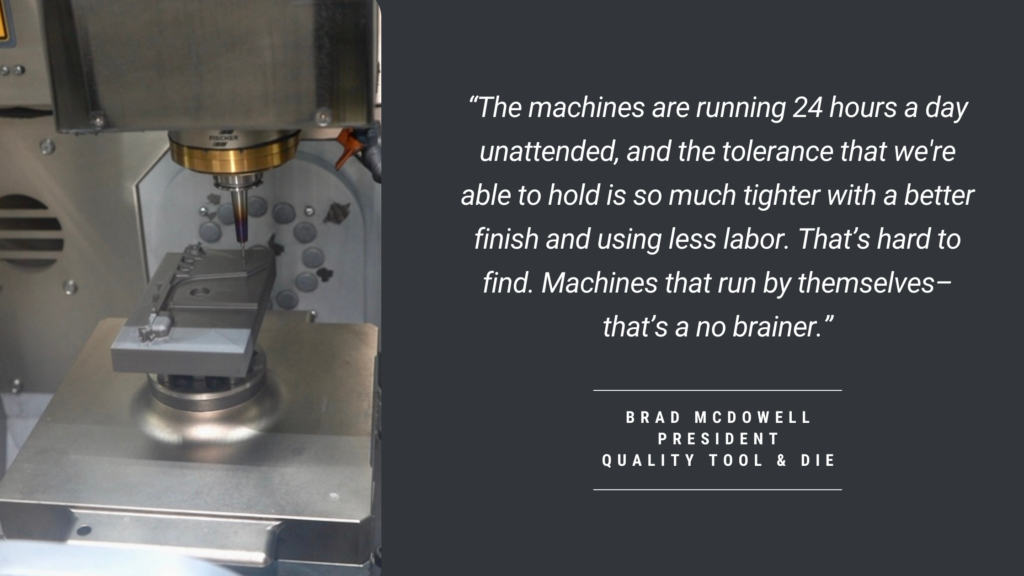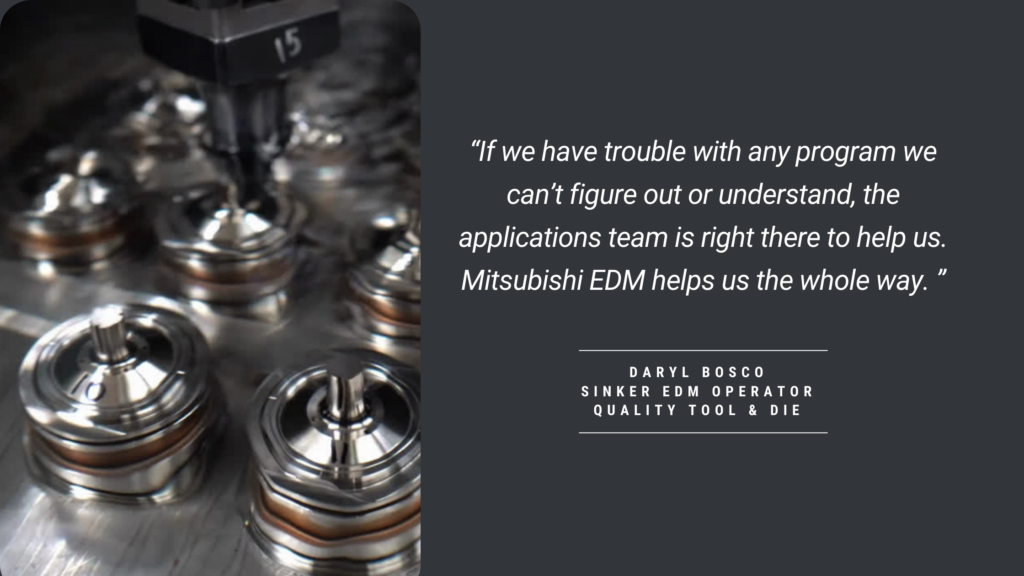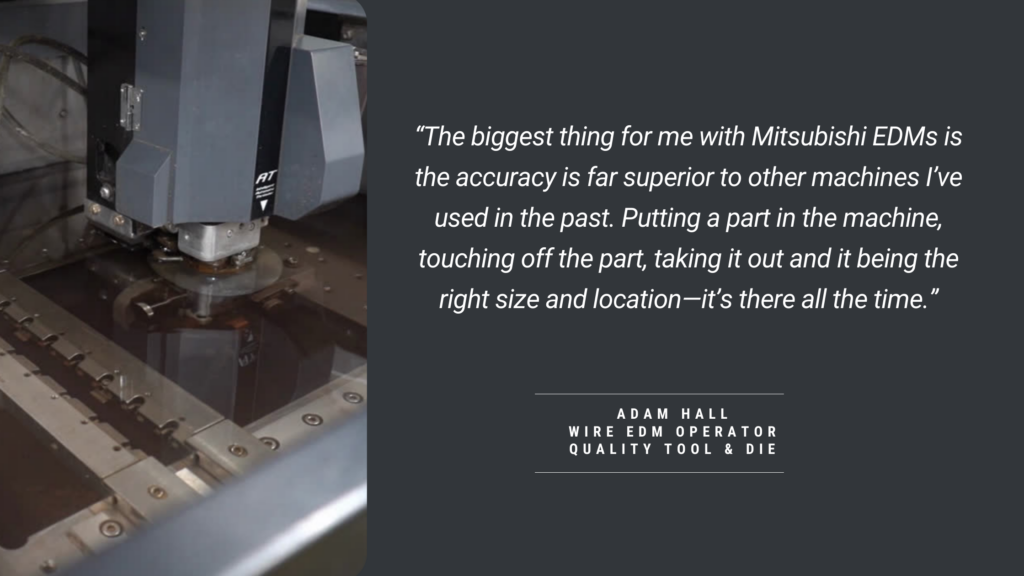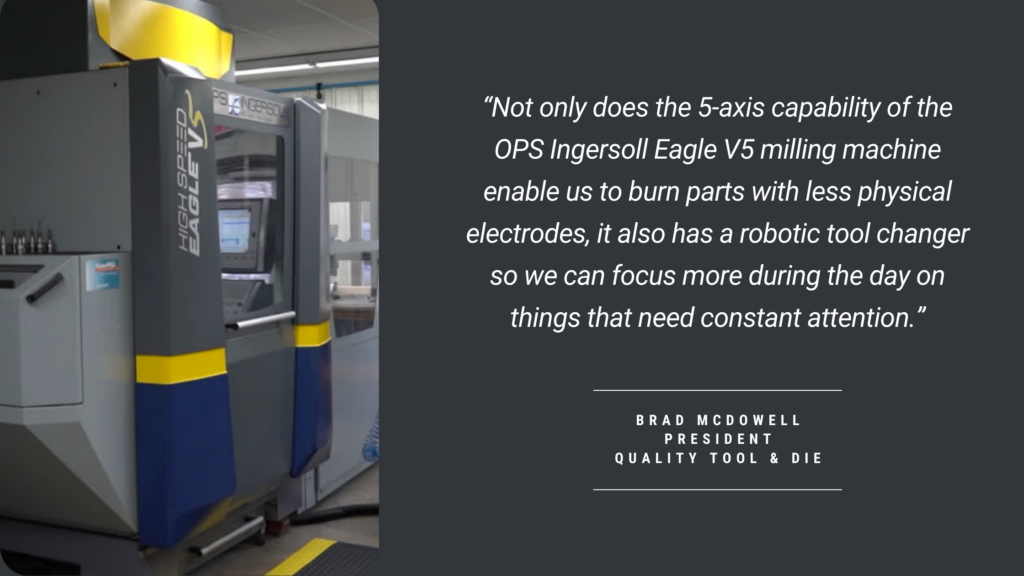Quality Tool & Die Finds Its Groove with Mitsubishi EDMs and OPS Ingersoll Milling Machine
Quality Tool & Die has found its groove, in no small part because of its strategic use of Mitsubishi wire and sinker EDMs and an OPS Ingersoll five-axis milling machine with automated cell.
The Meadville, Penn. company was founded in 1976 and purchased by Brad McDowell and Chad Kearns in 2005. It was a rocky start, however, when a business that owed them $70,000 in receivables went bankrupt.
“We really had to tie our shoes tight there for a while,” said Kearns, QTD vice president. “We struggled through it, and it turned out to be a great thing. It was primarily an automotive spare parts supplier, but over the years we’ve turned it into building complete custom molds for our customers.”
When McDowell and Kearns first bought the company, most of the equipment was manual and outdated. In 2013, they bought their first Mitsubishi sinker EDM and “saw the deep benefits right out of the gate” because of the machine’s ability to run unmanned, said Kearns.

Things turned around so much that QTD moved into a larger facility to 2014, which they recently expanded to 30,000 square feet.
QTD has evolved from a job shop to a complete tool-building company that now has 17 employees in the tool shop and another 13 in the plastic injection molds division added in 2014. Business has been growing 10 to 15 percent a year, McDowell said.
Mitsubishi SV12P Sinker EDMs
QTD now has four Mitsubishi sinkers, which produce the same or more work than the 13 machines they replaced. Sinker EDM Operator Daryl Bosco said the Mitsubishi SV12P, QTD’s newest sinker that has adaptive artificial intelligence, is incredibly easy to use.
“You don’t have to do anything but push a couple of buttons and it goes to mid points, center points–everything you want is right there on the pendant,” he said. “It makes life simpler. This thing is touch off, write the program, hit the start button and the machine does it for you.”
Applications Support

MC Machinery’s applications support has been a huge asset to QTD, McDowell said.
“My operators even have cell phone numbers for people to call,” McDowell said. “The knowledge there is able to get us up and going if we run into a tight spot, like if we haven’t EDMed a type of material before and we’re struggling with it–what are the settings, overburn, things like that.”
Mitsubishi Wire EDMs

QTD replaced wire EDMs made by another manufacturer with two Mitsubishi wire EDMs in 2021. The Mitsubishi MV models eliminated the need to manually grind the outside of the part–the old EDMs left skim stock because they didn’t hold location well enough.
“We’ve eliminated an entire operation,” said Wire EDM Operator Adam Hall. “Everything comes off the wire done and ready to go.”
OPS Ingersoll Eagle V5 Milling Machine
After adding their third Mitsubishi sinker, QTD realized they needed a way to supply enough graphite electrodes to keep them running lights out. That led to replacing a three-axis machine with the OPS Ingersoll Eagle V5 five-axis milling machine with automated cell in 2018.
The addition of the V5 mill proved to be a game changer. Not only did it completely eliminate bottlenecks caused by not having enough electrodes to keep the four CNC sinkers running lights out, but the milling machine also produces more precise electrodes, resulting in reduced electrode consumption. This saves time as well as money spent on graphite.
“We used to struggle with tool deflection on deep cuts,” Kearns said. “Now we’re able to tip that up in a five axis and actually hit on the bottom of the flute. And we’re not getting that tool push anymore. Electrodes are so, so much more accurate.”

The five-axis machine’s 42,000 RPM spindle allows QTD to cut intricate details into electrodes that they couldn’t do before. The ability to tip and turn and cut deeper rib features with a shorter tool produces a better electrode. Even better, what used to require three or four electrodes on the sinkers now takes only one or two.
“Before, we had to break up into three or four electrodes to burn all the necessary surfaces that we wanted,” McDowell said. “Now, maybe we do it in one or two electrodes. So not only does the V5 make electrodes faster, but we have to make half as many.”
In fact, the V5 is so productive, McDowell said it’s feeding the four sinkers while not even close to capacity. He thinks it could supply electrodes to another three to four sinkers without a problem.
